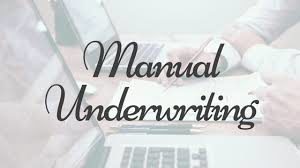At some point in your life, you might consider getting a loan to meet certain needs. Most people secure loans to buy a house mostly known as home loans or build a business. Whatever your needs are, I will advise you to find out the cons and pros of your decision. Now find out how to get a loan approval through manual underwriting mortgages, FHA, and VA loans all in detail below.
What Is manual underwriting?
Manual underwriting is a total check and balance done manually to assess your qualifications for a loan. In other words, it is a process whereby a person judges your ability to repay a loan before that loan can be signed/issued. Therefore, instead of having a computer algorithm analyze your request for a loan, an individual or group of individuals review your finances in detail to determine whether or not your application should be approved.
Manual underwriting is done by a living human and not a computer program. The person or group of persons working on your loan is called an underwriter. They will review your loan application and use supporting documentation to figure out whether or not you can afford a mortgage. An underwriter also decides if your loan will be approved, denied, or suspended. Manual underwriting most times takes a longer process than the automated process.

Manual Underwriting Mortgages
I am going to break this down bit by bit, when you hear the word mortgage the next thing that should be going through your mind is collateral. Therefore in detail, a mortgage is collateral in documents you present to an underwriter to replace the loan you are requesting for. However, if you are not able to pay back the loan before the deadline. Whatever property you used for the mortgage will be confiscated.
Therefore, when you start off your mortgage application, your lender decides if you qualify for a loan. Your lender will go through your information and find out if you will be able to pay back the loan. In most cases, the decision is made by a computer
A manual underwriting mortgage is a type of loan that is underwritten using a manual process, rather than an automated standard. Most people process mortgages using automated review systems. Take for example a borrower with a high credit score that is in the habit of borrowing and repaying loans that can be processed quickly with an automated review. However, for a borrower with a unique financial situation. The lender may choose to process this person using a manual underwriting process so that the computerized application does not reject their loan. At that point, you can provide additional documentation of your ability to repay the debt that is not being detected through your credit score.
The Process of Underwriting mortgage
Manual underwriting mortgages may be complex to process. This is because the borrower may have complicated financials and documentation. However, it is an uncommon way for a lender to find out if you can afford to repay a loan. Therefore, a mortgage person will be assigned to review your application. If you’re not the borrowing type or a debt-free person I will advise the manual process because your application may be rejected on an automated process.
Requirements
If you’re going through the manual underwriting here is a list of documents you will be needing.
#1.Financial Information
You should most importantly note that Before any manual underwriter can decide if you qualify for a mortgage, they need to understand your financial situation. Your lender will ask you for documents like:
- Most recent bank statements
- Anything that verifies your employment
- Most recent pay/salary, that’s shows you have a reliable and sustainable income
- Statements on your profits and losses whether you are self-employed or not.
- Documents of any assets you own like a car or a store
- Tax returns
#2.Assessment On Your Credit Report
Your credit report provides your manual underwriter with information about your connection to debt. It also shows information like your past loans, credit accounts and last payments on your accounts. When your underwriter goes through your credit report. They are trying to find out if you have a history of regular and punctual payments. Records of punctual payments on rent, utilities etc. Having records of punctual payments can increase your chances of approval. However, if there are any issues you may be asked to tender a letter of explanation. Not to panic, this doesn’t slim your chances of loan approval, it’s just a way for the underwriter to understand your report. It also shows your lender is considering approving your loan.
#3.Assessment On Your Income And Assets
The underwriter takes a look at your personal income and assets. Your lender will like to know how much money is your income and compare it to how much you’ll need to pay each month if they approve your loan. Your underwriter will also be looking at anything that you own that has significant value (an asset).
The goal of analyzing your assets is to ensure that you’ll be able to cover your closing costs, down payment, and keep up with your loan payments.
#4.Assessment On Your Debt And Responsibilities
One of the first things your lender will calculate is your debt-to-income ratio. This ratio tells a lot about how much of your monthly income goes toward expenses. If you use most of your income on things like credit card payments, rent, and loan payments. Then there are chances your DTI ratio will be very high. It’s better to have a lower DTI ratio when applying for a loan. With a lower ratio, your lender can be sure you still have some leftover cash even after taking care of your responsibilities. Your lender wants to be sure you will be able to afford a mortgage and also cover all your debt in the future. These factors will determine your underwriter’s decision.
#5. Assessment Of Your Collateral
Finally, in manual underwriting your underwriter considers your collateral -that’s your property value and your down payment.
The higher the down payment you bring to the table, the less of a risk you are to a lender. For instance, the value of your down payment is higher than the amount you intend to borrow. You will need at least a 3% down payment. Your down payment or collateral has to come from something you personally own. So that your underwriter doesn’t have to reject your request for a loan. So to be on the safer side don’t borrow to get a loan.
Your underwriter will search through your bank statements to determine where your down payment is coming from. Large or sudden deposits will trigger a red flag. You may need to write a letter of explanation for any unusual deposits outside of your standard income. You’ll also need documentation to back up your claim.
Therefore, note that whatever property you bring as collateral will be assessed to find out the actual value of the property. Your lender will not want to loan out more than your property is worth. So if you need a large sum of money you will need the worth of your collateral to be high. Finally, after all, protocols are observed your underwriter will then issue a final decision on your loan application. Who knows your loan might get approval.
Manual underwriting FHA

The Federal Housing Administration (FHA) is a loan system under manual underwriting. Recently, FHA manual underwriting updated the way that it assesses mortgage risk. But despite this change, it’s important to note that an FHA manual underwrite is not a decline on your loan request. Manually underwritten loans just go through a more extensive process.
Moreover, the FHA manual underwriting mortgage scorecard system TOTAL. This means technology is open to approved lenders this system flags certain loan applications for manual underwriting automatically. So, the majority of FHA loans still fall under TOTAL scorecard approval except the application activates the system based on risk factors. These factors are :
#1.Cash Lifestyles:
When you Lack sufficient credit history to generate a score. This will activate a manual underwriting referral with the FHA.
Financial Shortfalls:
Getting mortgage approval may be difficult if you are having a financial problem such as bankruptcy or foreclosure. You will have to meet requirements for a waiting period after significant derogatory credit events. If you have satisfied the requirements, a manual underwrite may lead to loan approval in situations where an automated approval would still be off the table.
Debt-to-Income:
The amount of total debt you have in comparison to your overall income is your debt-to-income ratio. Although this factor has a bearing on FHA approval, manual underwriting administrators may balance the ratio against other factors that support approval. In some cases, home loans can be approved at ratios of 40-50 percent.
It’s important to keep in mind that a referral for a manual underwriting review does not necessarily result in a rejection. However, your application could be walking a thin line, and it will be in your best interest to work with your Mortgage Advisor to demonstrate an ability to pay.
Other factors that can help your mortgage application gain approval
- Having enough liquid assets to cover three or more months of payments.
- On-time payments off all of your credit cards and other optional debt each month. This shows your lender you have a solid credit history as well as an improved ability to repay a mortgage.
- A manual underwriter will also be looking at your extra earnings. To be sure you will be able to take care of your responsibilities and also afford a mortgage.
If your application receives an FHA referral for manual underwriting, that’s fine. A manual underwrite could prove a valuable method for loan approval.
Manual underwriting VA loan
Manual underwriting VA loan is another review system of underwriting. Under the manual underwriting VA loans, there is no maximum debt ratio. However, the lender must provide compensating factors if the total debt ratio is more than 41 percent. There is also no minimum credit score requirement. Instead, VA requires a lender to review the entire loan profile.
Moreover, VA’s residual income guidelines ensure Veteran borrowers can afford the loan. These guidelines establish how much money residue a Veteran must have after all debts and living expenses are considered.
When applying for a VA loan you may require a minimum credit score of 620, 600, or 580 or you must have a debt to income ratio of no more than 41 percent. These are called Lender Overlays to the VA underwriting guidelines.
A lot of times when a Veteran has higher Debt to Income ratios, lower credit scores, and or past credit charge off or collection accounts a Manual Underwrite is necessary. A manual underwrite is when you do not receive automated approval from the automated underwriting system.
Requirements Manual Underwritten VA Loan
- You must have a unique credit history. Like not having any late payments in the past 12months.
- You must have a 24 months rent history.
- Rent-free and living with family is a valuable key to VA manual underwriting.
- If you have any other issues you may have to present a letter of explanation.
Considerable factors that can boost your VA loans
- Minimal consumer debt
- Long-term employment
- Significant liquid assets
- Sizable down-payment
- The existence of equity in refinancing loans
- Little or no increase in shelter expense
- Military benefits
- High residual income
- Low debt-to-income ratio
Finally, Most importantly make sure you are working with a Loan Officer and Lender who will take the time to review all your VA loan options and has experience working with manually underwritten VA loans.
Frequently Asked Question
Do credit unions do manual underwriting?
Many credit unions use manual underwriting to get around Fannie Mae’s strict standards, allowing borrowers who don’t check all of the required boxes to get a mortgage.
How long does manual underwriting take?
Mortgage underwriting can take a day or two, or weeks, depending on these factors. Initial underwriting approval usually occurs within 72 hours of submitting your complete loan file. This process could take up to a month in the worst-case scenario.
What should you not do during underwriting?
During the loan process, do not resign or retire from your current job.
Before your new mortgage loan closes, don’t open any new credit accounts or apply for any new credit accounts.
Make no balance transfers from your existing credit card accounts.
- Mortgage: Simple 2021 Guide for Beginners and all you need Updated!!!
- Mortgage Underwriter: Process, Salary, Jobs & How To Become an M.U Guide.
- Personal loan application: Step by step guide (+ quick tips)
- VIRTUAL ASSISTANT BUSINESS: 2021 Detailed Start-Up Guide (+ Free Tips)
- MARKETING STRATEGIES FOR E-COMMERCE BUSINESS
- CONSUMER LOANS: Definition, Types & Rates
- FHA APPROVED CONDO: The updated list & How to get one (+ free tips)
- What Credit Score Do You Need to Buy a House: Best US Practices in 2021






